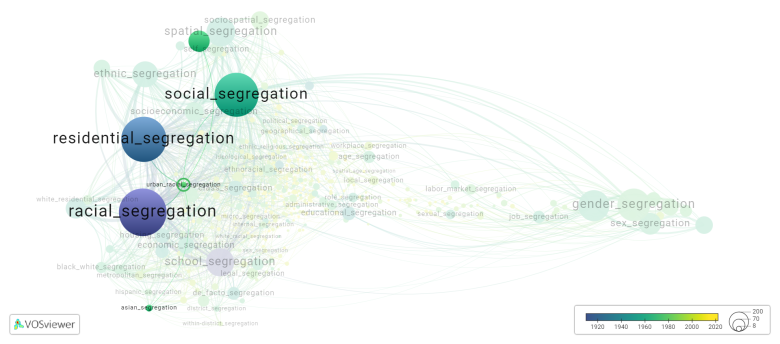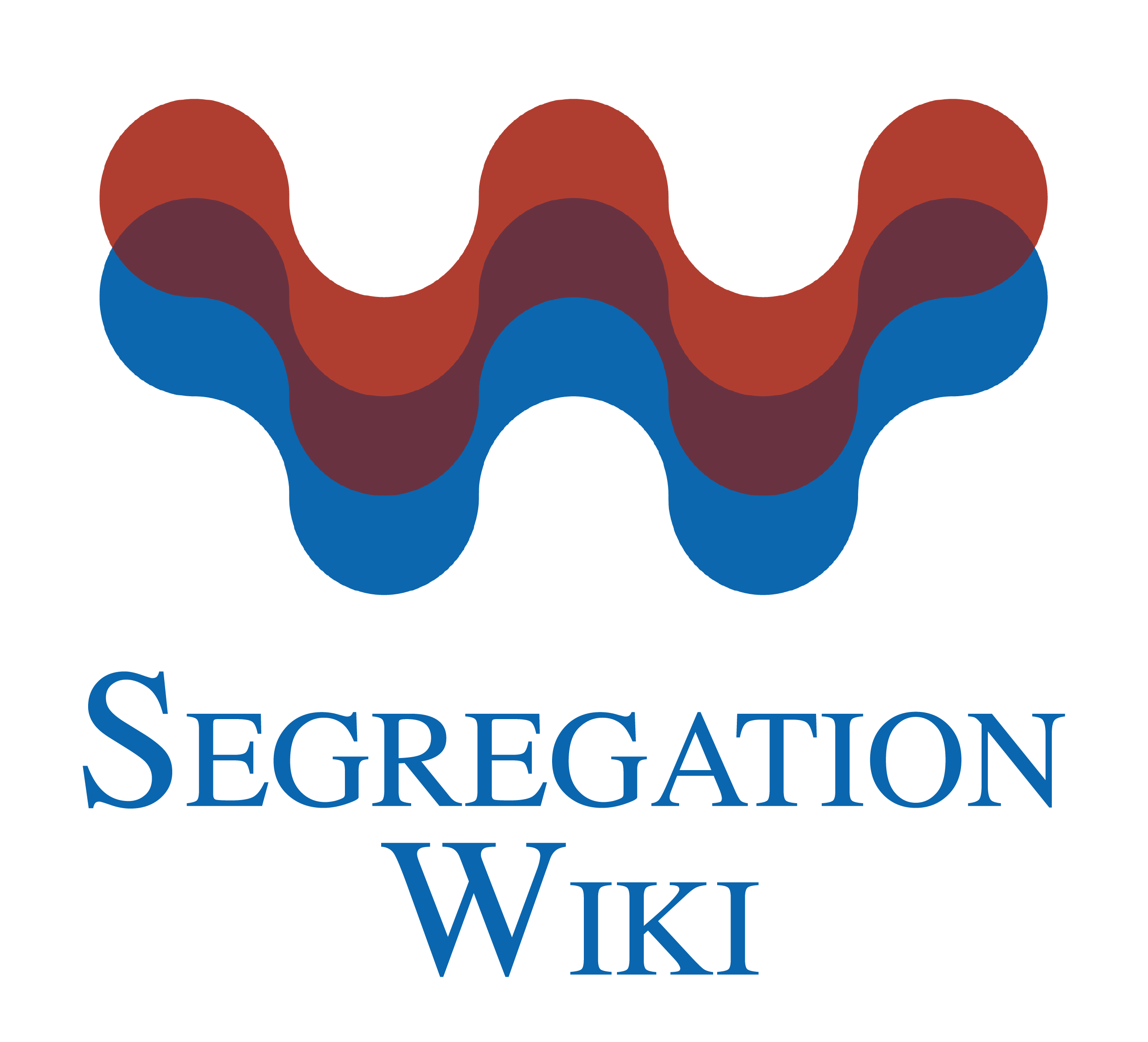Urban racial segregation: Difference between revisions
(Creating page) |
(Creating page) |
||
| Line 15: | Line 15: | ||
Urban racial segregation is frequently discussed in the literature with the following segregation forms: | Urban racial segregation is frequently discussed in the literature with the following segregation forms: | ||
[[ | [[racial segregation]], [[residential segregation]], [[urban segregation]], [[social segregation]], [[ethnic segregation]], [[tract segregation]], [[racial residential segregation]], [[spatial racial segregation]] | ||
[[File:urban_racial_segregation.png|780x780px]] | [[File:urban_racial_segregation.png|780x780px]] | ||
| Line 21: | Line 21: | ||
For the complete network of associated segregation forms, see: | For the complete network of associated segregation forms, see: | ||
year of publication https://tinyurl.com/2235lkhw | |||
Louvain clusters https://tinyurl.com/2d8wg5n3 | |||
betweenness centrality https://tinyurl.com/223udk5r | |||
disciplines where segregation forms first appeared https://tinyurl.com/244d8unz | |||
==References== | ==References== | ||
==Notes== | ==Notes== | ||
Revision as of 14:39, 27 September 2024
Date and country of first publication[1]
1984
United States
Definition
Urban racial segregation refers to the pattern of racial groups living in separate residential areas within a city. It is the separation of different racial and ethnic communities, resulting in distinct neighborhoods characterized by their racial composition.
There are several causes and consequences of urban racial segregation. Historical racial discrimination, redlining, and restrictive housing policies have contributed to the creation and perpetuation of segregated neighborhoods. Economic disparities, educational inequalities, and social factors have also played a significant role.
Racially segregated neighborhoods often face issues such as concentrated poverty, limited access to resources and opportunities, lower-quality housing, inadequate public services, and higher crime rates. This can result in a cycle of disadvantage and perpetuate racial inequalities.
Efforts to reduce urban racial segregation involve various strategies, such as fair housing policies, affordable housing initiatives, the promotion of inclusive neighborhood planning, and community development programs. Additionally, fostering diverse and inclusive communities through education, economic opportunities, and social integration is crucial for addressing this issue.
See also
Related segregation forms
Urban racial segregation is frequently discussed in the literature with the following segregation forms:
racial segregation, residential segregation, urban segregation, social segregation, ethnic segregation, tract segregation, racial residential segregation, spatial racial segregation

For the complete network of associated segregation forms, see:
year of publication https://tinyurl.com/2235lkhw
Louvain clusters https://tinyurl.com/2d8wg5n3
betweenness centrality https://tinyurl.com/223udk5r
disciplines where segregation forms first appeared https://tinyurl.com/244d8unz
References
Notes
- ↑ Date and country of first publication as informed by the Scopus database (December 2023).
At its current state, this definition has been generated by a Large Language Model (LLM) so far without review by an independent researcher or a member of the curating team of segregation experts that keep the Segregation Wiki online. While we strive for accuracy, we cannot guarantee its reliability, completeness and timeliness. Please use this content with caution and verify information as needed. Also, feel free to improve on the definition as you see fit, including the use of references and other informational resources. We value your input in enhancing the quality and accuracy of the definitions of segregation forms collectively offered in the Segregation Wiki ©.
Urban racial segregation appears in the following literature
Logan J.R., Stearns L.B. (1981). Suburban Racial Segregation as a Nonecological Process. Social Forces, 60(1), 61-73. Oxford University Press.https://doi.org/10.1093/sf/60.1.61
Clark G.L. (1984). Who’s to blame for racial segregation?. Urban Geography, 5(3), 193-209. https://doi.org/10.2747/0272-3638.5.3.193
Nel E.L. (1991). Racial segregation in East London, 1836 1948. South African Geographical Journal, 73(2), 60-68. https://doi.org/10.1080/03736245.1991.9713550
Lupton M. (1993). COLLECTIVE CONSUMPTION AND URBAN SEGREGATION IN SOUTH AFRICA: THE CASE OF TWO COLORED SUBURBS IN THE JOHANNESBURG REGION. Antipode, 25(1), 32-50. https://doi.org/10.1111/j.1467-8330.1993.tb00215.x
Robinson J. (1997). The geopolitics of South African cities: States, citizens, territory. Political Geography, 16(5), 365-386. Elsevier BV.https://doi.org/10.1016/s0962-6298(96)00019-4
Christopher A.J. (2001). Urban segregation in post apartheid South Africa. Urban Studies, 38(3), 449-466. Carfax Publishing Company.https://doi.org/10.1080/00420980120080031
Rohe W.M., Freeman L. (2001). Assisted housing and residential segregation: The role of race and ethnicity in the siting of assisted housing developments. Journal of the American Planning Association, 67(3), 279-292. https://doi.org/10.1080/01944360108976236
Ellis M., Wright R., Parks V. (2004). Work together, live apart? Geographies of racial and ethnic segregation at home and at work. Annals of the Association of American Geographers, 94(3), 620-637. https://doi.org/10.1111/j.1467-8306.2004.00417.x
Corrigall M. (2018). Reframing Johannesburg’s urban politics through the lens of the Chinese Camera Club of South Africa. Social Dynamics, 44(3), 508-525. Centre for African Studies.https://doi.org/10.1080/02533952.2018.1503036
Tewolde A.I. (202). Experiencing de facto Racial Residential Segregation in Urban South Africa: An African Refugee's Auto ethnography1. Urbanities, 10(2), 109-123. Il Denaro Group.https://doi.org/
Liu Q., Liu M., Ye X. (2021). An extended spatiotemporal exposure index for urban racial segregation. Cartography and Geographic Information Science, 48(6), 530-545. Taylor and Francis Ltd..https://doi.org/10.1080/15230406.2021.1965915
Dmowska A., Stepinski T.F. (2022). Improving assessment of urban racial segregation by partitioning a region into racial enclaves. Environment and Planning B: Urban Analytics and City Science, 49(1), 290-303. SAGE Publications Ltd.https://doi.org/10.1177/23998083211001386
